Here's a list of Keith Kohl's stock picks that we've exposed over the years and that we'll do our best to keep up-to-date.
To make this list more convenient, I'll be adding his latest picks to the top so that you don't have to scroll down so far 🙂
Table of Contents
- 2025 Picks
- 2024 Picks
- 2023 Picks
- 2022 Picks
- Picks from 2021
- Picks from 2020
- Who Is Keith Kohl?
- Conclusion & Should You Buy Keith Kohl's Recommendations?
Got a recommendation that's not on the list? Let us know in the comment section below this post
2025 Picks
“AI Doctor” Biotech Pick
- Title of Teaser Presentation: “World Stunned as ‘AI Doctor' Produces Cures at Light Speed”
- Name of “Special” Reports: “Bioengineering: Cashing in on AI Drug Development Before It’s Too Late”
- Promoted Under: Topline Trader

Keith Kohl is pitching an “AI Doctor” – a small biotech he says can use artificial intelligence to design new drugs at “light speed,” fixing the slow, expensive, hit-or-miss way pharma has worked for decades. The stock’s name is paywalled inside his Bioengineering report, which you only get by subscribing to his Topline Trader service for $799. The big idea is AI-enabled drug discovery: instead of random lab work and lucky finds, software models protein structures and cellular biology, then screens potential drugs in silico. This is the same broader trend big reports from the likes of McKinsey and Morgan Stanley say could shave years and billions off development timelines and costs in pharma.
The clues in Kohl’s teaser are pretty specific: his company’s first AI-discovered cancer treatment is already in clinical trials, it has partnerships with Roche, Sanofi, Merck, and Bayer that have brought in about $455 million with the potential for roughly $20 billion more in milestones, and it supposedly still trades under a $3 billion valuation and under $5 a share. That combo points straight at Recursion Pharmaceuticals Inc. (Nasdaq: RXRX), whose own materials highlight those same big-pharma partners and milestone-heavy collaboration deals. Similar to other AI pitches we've seen – real technology and a growing market — analysts see AI in drug discovery as a multibillion-dollar space by 2030 — wrapped in “biotech of the decade” marketing.
Our Green Bull write-up does a good job tapping the brakes: Recursion is still a pre-revenue, clinical-stage biotech, with most programs in early human trials and a long way to go before any FDA approval. AI can make drug discovery faster and cheaper, but it doesn’t remove clinical or regulatory risk, and as even mainstream outlets like MoneyWeek point out, small AI biotechs usually end up partnering with – or being bought by – the same big pharma names they’re supposedly disrupting. So while Kohl talks about Recursion becoming a bigger name than Pfizer or Merck, the more realistic “win” for investors is probably a successful trial or a takeout at a premium, not a solo march to mega-cap status.
>> Read the full write-up here
His Canadian Oil Stocks
- Title of Teaser Presentation: “Exposed: Warren Buffet's U.S. Market Escape Plan”
- Name of “Special” Reports: “Buffett’s Escape Plan: 4 Canadian Oil Stocks Ready to Skyrocket”
- Promoted Under: Energy Investor

Mr. Kohl frames this as Buffett’s favorite playbook: hoard cash into a peak, then buy cash-gushing energy after the fall. With Berkshire’s cash near the stratosphere and Canada’s Trans Mountain expansion finally shoving more barrels to tidewater, Kohl says a handful of Canadian producers are set up for classic value gains. If this pitch feels familiar, that’s because Kohl has worked this lane before—see the earlier breakdowns of his “#1 Oil Stock of the Decade” and his rare-earths angle in “American Miner Breaking China’s Metals Monopoly”.
First, the clues he drops (before any names):
- Buffett-style setup: record Berkshire cash pile and a pricey market, with Buffett historically deploying after selloffs.
- Macro catalyst: Trans Mountain’s expansion lifting export capacity to the Pacific, with early loadings around 550,000-barrel Aframax cargos headed to Asia.
- Company tells: one is the biggest Canadian oil sands producer focused on returning up to 100% of free cash flow; another is ~100k bbl/day and roughly a $7B cap; one loaded an early TMX cargo to China; another announced a 195,000 bbl/day oil-sands mine boost right after TMX opened; and one is running a fully autonomous haul-truck fleet at a flagship mine.
Match the clues to the tickers and you get: Cenovus Energy (NYSE: CVE) as the capital-return machine; MEG Energy (OTC: MEGEF) around the 100k bbl/day mark; Suncor (NYSE: SU) tied to that first outbound TMX shipment to China; Canadian Natural Resources (NYSE: CNQ) with the prompt 195k bbl/day Horizon expansion note; and Imperial Oil (NYSE: IMO) with the autonomous haul-truck fleet at Kearl. The timing lines up with the infrastructure backdrop—Trans Mountain’s expanded line launched with ~550k-barrel loadings and Asian-bound cargos, and management expects continued throughput and marine loading constraints around Aframax drafts near 550k barrels—the very choke points that can fatten realized pricing for well-positioned sellers. On the Buffett side of the pitch, the war chest is real: Berkshire’s cash pile has been hovering at fresh records, a setup even mainstream outlets have flagged as classic “dry powder” territory, with Reuters noting $347.7B as of Q1 2025. That’s the kind of backdrop this teaser leans on.
Bottom line: this is a straightforward “pipes open, cash flows follow” value story dressed in Buffett cosplay. The names are solid operators and the export outlet is real, but—as with most teasers—the 10x talk glosses over commodity cyclicality and the slow grind of de-bottlenecking. Still, if you like the energy-upside-with-dividends lane, these are credible candidates—much like Kohl’s past energy pitches and other commodity-heavy promos we’ve dissected.
>> Read the full write-up here
The “#1 Nuclear Stock” for AI Supremacy
- Title of Teaser Presentation: “The Final Battle for AI Supremacy”
- Name of “Special” Reports: “The #1 Nuclear Stock Fueling the AI Arms Race”
- Promoted Under: Energy Investor
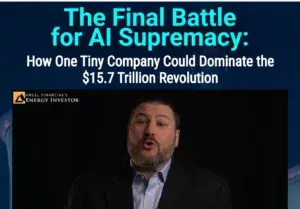
Keith Kohl’s pitch ties the artificial intelligence boom to an urgent new energy crisis — AI’s power hunger. He claims that protests are erupting over AI’s strain on the grid, and that only one rare, irreplaceable energy source can sustain the coming wave of artificial general intelligence: nuclear power. His “#1 Nuclear Stock” supposedly holds the key, operating today’s reactors while pioneering tomorrow’s Small Modular Reactors (SMRs) — compact, factory-built reactors that many see as the future of clean, reliable energy.
The clues are telling:
- Operates seven nuclear reactors across the U.S., producing 52.7 million megawatt-hours annually
- NRC license renewals for 20 more years
- Backed by Amazon, with a $500 million investment to develop an SMR in Virginia
Those details point squarely to Dominion Energy Inc. (NYSE: D). Dominion runs seven reactors across three states, including the North Anna Power Station where it’s partnering with Amazon on SMR development. The NRC license extensions and Amazon tie-in seal the match.
SMRs have also been a hot topic in other teasers we've covered, such as Tilson's Nuclear Renaissance stocks.
Dominion, of course, is no scrappy startup. It’s a traditional utility trading at under 2x book value, yielding about 4%. Kohl’s talk of “explosive profits” is a stretch — utilities aren’t known for fireworks. Still, Dominion’s steady income and early SMR exposure make it a solid long-term play if SMR deployment finally accelerates.
>> Read the full write-up here
The “American Miner Breaking China’s Metals Monopoly”
- Title of Teaser Presentation: “Bigger Than Doge”
- Name of “Special” Reports: “The American Miner Breaking China’s Metals Monopoly”
- Promoted Under: Energy Investor
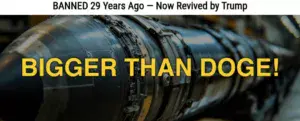
Keith Kohl is pitching a patriotic-sounding solution to a very real choke point: China’s grip on gallium, germanium, antimony and other critical minerals. The setup leans on the 1990s closure of the U.S. Bureau of Mines and the resulting import dependence, then fast-forwards to today’s export restrictions and supply-chain rerouting. If you’ve sat through rare-earths promos before—like Dylan Jovine’s Pentagon-backed pick or Mizrahi’s battery-materials pitch—you know the drill: national-security crisis meets tiny “made-in-America” miner with outsized upside.
Here are the clues Kohl drops before naming anything:
- The properties sit in Idaho’s central belt and include three of the top ten U.S. rare-earth prospects.
- The company also owns a gold mine with ~$1.2B in contained gold and is already producing.
- Deposits have been recognized by USGS/DoE as critical for national security.
- It’s been added to the National Strategic Rare Earth Inventory (as pitched).
- Stock around $10; balance sheet light on debt, cash on hand, and positive revenue.
Line those up and the teased “American miner” matches Idaho Strategic Resources (NYSE: IDR). The central Idaho land package and Golden Chest Mine check the geography/operating boxes, and the company has been leaning into its REE exploration while reporting improving quarterly revenue from gold operations. The broader backdrop also fits: China’s curbs on strategic minerals supply have tightened since mid-2023 and morphed into outright U.S.-specific bans on gallium, germanium and antimony—context Reuters has been tracking in depth—while industry groups have even pushed Washington to revive the long-dormant Bureau of Mines to boost domestic supply. Those two forces (policy tailwinds + constrained imports) are exactly what these teasers love to weaponize.
Reality check: IDR is a real operator with a clean-ish balance sheet and growing gold revenue, exploring REE targets in Idaho. That gives it leverage to any U.S. push for critical-minerals independence, especially as China’s export controls ripple through prices and flows, and as D.C. floats ideas to resurrect the Bureau of Mines to streamline domestic production. Just keep expectations tethered: exploration timelines are long, and one micro-cap won’t “break China’s monopoly” alone.
>> Read the full write-up here
Companies Paying “AI Equity Checks”
- Title of Teaser Presentation: “5 Companies Are Paying Out ‘AI Equity Checks' Worth as Much as $41,430 a Year!”
- Name of “Special” Reports: “AI Equity Checks: The Lifelong Artificial Intelligence Income Stream”
- Promoted Under: Technology and Opportunity
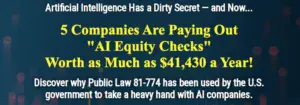
Keith Kohl pitches a “brand-new” income stream tied to the AI boom and hints you could pocket your first payment by April 23. The story leans on Washington’s growing role in AI oversight and claims that Big Tech is quietly paying a handful of “special companies,” which then pass those payments to regular shareholders as recurring “AI Equity Checks.” We’ve seen these playbooks before.
First, the clues Keith drops before any names:
- AI development is now under federal scrutiny; he cites the Defense Production Act and says companies training “high-powered” models must report to the Commerce Department. The White House’s 2023 AI Executive Order did invoke DPA authorities to compel reporting from developers of the most capable models, per the administration’s own fact sheet (see Fact Sheet: President Biden Issues Executive Order on Safe, Secure, and Trustworthy AI).
- Big AI players (Alphabet, Amazon, Microsoft, Nvidia, Intel) are striking content/data licensing deals to feed their models.
- A select set of companies “receive regular payments” from AI firms and “pass them on” to shareholders—rebranded as “AI Equity Checks.”
- The buy-in can be “as little as $10.”
- A separate teased idea: a company that “gives AI its ears” via state-of-the-art microphones; it’s sub-$2B and its tech shows up in Kia cars and VIZIO TVs.
How that maps to real tickers revealed in the exposé: these “checks” are just ordinary dividends (or potential distributions) from content/data owners licensing material to AI firms. Real deals exist—Reddit’s licensing pact with Google was pegged around $60M per year, according to Reuters (see Reddit in AI content licensing deal with Google), while media groups and stock-image libraries like Shutterstock and News Corp have also inked training-data agreements (Reuters covered News Corp’s OpenAI deal, for example). The exposé flags several names that fit the pattern—Shutterstock (SSTK), Reddit (RDDT), News Corp (NWSA), and LiveRamp (RAMP)—but only some of these actually pay regular dividends today, and none are obligated to funnel “AI licensing dollars” directly to you. The “$10” bit is just share-price optics, not a special program.
As for the “one more AI opportunity,” the voice-interface clues line up with SoundHound AI (SOUN)—its conversational AI is integrated in autos and consumer devices (yes, including Kia and VIZIO), and it’s a frequent target of “AI ears” teasers we’ve seen, like the one we unpacked in Jason Williams’ “Tiny AI Stock With 5,300% Upside” Revealed.
Bottom line: “AI Equity Checks” is a marketing label for ordinary dividend (or potential cash-flow) plays tied to AI data licensing. The mechanism is real—AI companies are licensing content—but the income is still just standard dividend math, not a new government-mandated payout stream.
>> Read the full write-up here
His AI Robot Stocks
- Title of Teaser Presentation: “Tesla Is Going All-In on AI Robots”
- Name of “Special” Reports: “The $1 Trillion Robot Race: The Little-Known Company Set to Outshine OpenAI”
- Promoted Under: Technology and Opportunity
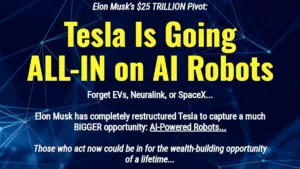
Keith Kohl is leaning hard into the humanoid robot boom, arguing Tesla’s Optimus will spark a mega-shift — but a different “AI Robot” play will steal the spotlight. Classic setup: big promise, limited details, and the ticker locked behind a $99 paywall.
Here are the clues dropped in the presentation before any names were revealed:
- The company originated from MIT and isn’t a new startup.
- It has customers in 35+ countries, with marquee users like SpaceX, DHL, and BP.
- Its “premier humanoid robot” is named “Atlas.”
- It also sells other specialized robots already working in U.S. warehouses.
- DARPA has called its humanoid “one of the most advanced ever built.”
- Two more picks were teased: one ranked in Fortune’s “Change the World” list, and another that builds 3D AI vision so robots can “see.”
Match the clues and the lead “AI Robot” pick is Boston Dynamics — famous for the humanoid Atlas plus commercial bots Spot and Stretch — which you can only access via parent Hyundai Motor (OTCMKTS: HYMTF). The Fortune recognition points to Honeywell (Nasdaq: HON), a diversified industrial with real automation exposure. And the “robots that see” angle lands on Cognex (Nasdaq: CGNX), the machine-vision specialist powering factory and logistics inspection. For context on what “robot vision” actually is, check out this quick explainer on machine vision, and to see how humanoids are creeping into real workflows, here’s Amazon discussing warehouse pilots with the Digit robot.
A reality check on the “25x in months”: robotics is a long runway story, not a meme rocket. Hyundai looks inexpensive with a Boston Dynamics kicker; Honeywell is steady-eddy industrial automation; Cognex is the purer bet but cyclical. The sizzle reel (Atlas doing acrobatics) sells the future, while most investable revenue today still comes from gritty factory/warehouse automation — a pattern we’ve seen before in those other AI teasers above.
>> Read the full write-up here
The “Next Nvidia”
- Title of Teaser Presentation: “The Next Nvidia”
- Name of “Special” Reports: “The $1 Trillion Robot Race: The Little-Known Company Set to Outshine OpenAI”
- Promoted Under: Technology and Opportunity
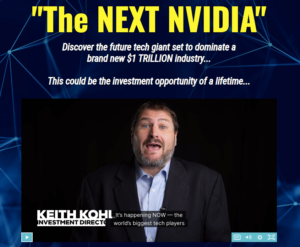
Kohl’s pitch says Big Tech is in a full-blown robotics arms race and one “lesser-known” player—his “Next Nvidia”—is already years ahead. The promise: AI brains don’t matter without legs and hands that move like humans, and his star supposedly nails mobility and manipulation, up to and including parkour.
Clues dropped before any names:
- Its tech is already used by SpaceX, Amazon, and the U.S. military.
- The company’s humanoid robot is called Atlas and it’s “all-electric.”
- It’s an “unlikely name” leading the AI-robot revolution.
Those breadcrumbs point straight to Boston Dynamics—maker of Atlas and now a subsidiary you access via Hyundai Motor Company (OTC: HYMTF), which took an 80% stake in a deal valued at $1.1 billion, as reported by Reuters. The “all-electric” hint lines up with the 2024 relaunch of Atlas, which The Verge covered when Boston Dynamics showed off a redesigned electric model built for “dull, dirty, dangerous” tasks rather than YouTube party tricks. If the “Next Nvidia” label feels familiar, that’s because we’ve seen the same playbook in other pitches, from Louis Navellier’s AI “Master Key” to Marc Lichtenfeld’s buzzy “TF3 chip” idea.
Bottom line: Kohl’s “Next Nvidia” isn’t a pure-play robot stock—it’s Boston Dynamics (private) inside Hyundai (public). Interesting strategic asset, but you’re buying a discounted auto conglomerate with a robotics option attached, not an AI-chip flywheel.
>> Read the full write-up here
2024 Picks
That “Nvidia Killer” Company
- Title of Teaser Presentation: “The ‘Nvidia Killer' Could Make You 120x Your Investment”
- Name of “Special” Reports: “The Nvidia Killer: Unlocking the $100 Trillion AI Boom”
- Promoted Under: Technology and Opportunity
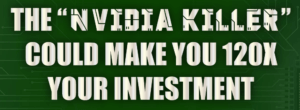
Keith Kohl says a small Sunnyvale outfit holds the patent-protected key to AI’s “fatal flaw”: the memory/computation bottleneck that makes today’s GPU stacks costly, hot, and hard to scale. It’s the same tiny-upstart-dethrones-giant framing we’ve seen before, echoing the infrastructure angle in Nomi Prins’ AI pick and the chip-savior vibe of Navellier’s “Master Key” teaser.
First, the clues he drops:
- Sunnyvale-based firm with a purpose-built AI chip
- About 125+ patents forming an “impenetrable moat”
- U.S. Air Force/Space Force involvement on a high-performance edge project
- Roughly 6,500x smaller than Nvidia, with a meme-y spike this year
- Claims of 100x performance on big-data workloads at ~60W power draw
Those breadcrumbs line up with GSI Technology (NASDAQ: GSIT). The company’s “Gemini” associative-processing design computes in memory to reduce the classic I/O choke point Kohl fixates on, and the “big announcement” thread ties neatly to GSI’s tape-out of Gemini-II, billed as delivering more than ten times the processing performance and eight times the memory density over Gen-I. The defense angle matches GSI’s feasibility work for the U.S. Air Force and Space Force on edge AI. Meanwhile, the broader context is real: AI data centers are straining grids and gulping water, a trend documented by Reuters, and the Iowa build that helped train GPT-4 required heavy cooling draws, as reported by the Associated Press.
Does that make GSI a true Nvidia killer? Not likely. “Tape-out” means design completion, not shipping volumes, and even if associative processing shines on certain search/embedding or database-style inference tasks, ripping and replacing entrenched GPU clusters takes years, contracts, and a supply chain — not a newsletter. More plausible: GSI carves out niche wins at the edge while the hyperscalers keep feeding their Nvidia farms. It’s speculation, not coronation — much like Kohl’s other moonshot setups, including his “Algo Meds” pitch.
>> Read the full write-up here
2023 Picks
The “Horseshoe Well” Company
- Title of Teaser Presentation: “The Trillion Dollar Drill”
- Name of “Special” Reports: “The ‘Horseshoe Well’: The Breakthrough Set to Revolutionize the $4.3 Trillion Oil Market”
- Promoted Under: Energy Investor
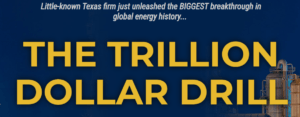
Keith Kohl (Angel Publishing) pitches a Texas driller with a supposedly game-changing “Horseshoe Well” that doubles back on itself—think a U-turn lateral—so operators can tap more rock with fewer wells, lower surface impact, and a big cut to drilling time and costs. Classic “biggest breakthrough since fracking” framing, and very on-brand for Kohl (see how he positioned his “#1 Oil Stock of the Decade” teaser a few weeks prior).
Here are the key clues dropped before any ticker shows up:
• 150,000 acres in the Permian Basin.
• CEO previously built a Texas oil company from $270k and later sold it for $388 million.
• Claimed ~$10 million savings by drilling two 2-mile laterals instead of four 1-mile wells.
• Record production around 130,000 boe/d and ~40% annual growth.
Those breadcrumbs line up with Matador Resources (NYSE: MTDR). The company’s own updates describe early “horseshoe” or U-lateral results and record production; see Matador’s Q3 2023 release noting initial production from its first two horseshoe wells and heightened volumes in the Delaware Basin in Loving County via its official Q3 report. The claimed cost advantage also matches trade coverage that Matador “expects to save $10 million” by opting for two U-shaped laterals over four shorter wells on the same acreage, as reported in PB Oil & Gas Magazine. If you want a broader sense of why these tweaks matter in shale, Reuters has long chronicled how operators squeeze costs by iterating on horizontal designs and completions, a theme echoed in its industry learning-curve analysis.
Bottom line: the “Horseshoe” is a U-turn horizontal — a real but incremental drilling optimization, not sci-fi. It can help on surface footprint, cycle time, and EURs, but MTDR’s returns will still hinge on inventory quality, well performance versus neighbors, balance-sheet management, and commodity prices. That’s the unsexy reality behind the sizzle.
>> Read the full write-up here
The “#1 Oil Stock of the Decade” Company
- Title of Teaser Presentation: “The #1 Oil Stock of the Decade”
- Name of “Special” Reports: “Hidden Gems of the Permian: 3 Little-Known Oil Producers Set to Soar in the New Bull Market”
- Promoted Under: Energy Investor

Keith Kohl says three forces — Washington’s policy drag, OPEC+ discipline, and a China-led demand pop — are lining up for a new multi-year oil bull. Classic Kohl: big cycle call, then a handful of “under-the-radar” producers he’ll name if you subscribe. The core promise is straightforward: skip “Big Oil” and ride smaller, cheaper names he thinks will have more torque if crude rips. For context, his macro talking points do have real-world echoes: China’s crude appetite set fresh records coming out of zero-COVID (Reuters notes 2023 imports hit all-time highs), and U.S. emergency stocks were drawn down to levels not seen since the 1980s (EIA flagged the SPR at its lowest since 1984 during the releases).
Here are the actual clues dropped before any ticker is named:
- The pick “sits on one of the biggest oil patches in the world,” with ~2.2 trillion barrels locked under the ground (that’s the Canadian oil sands’ “oil in place”).
- It’s trading near a low valuation while sporting its strongest balance sheet in years.
- It’s strategically positioned in Alberta’s oil sands.
- Beyond the headliner, Kohl hints at three small-cap Permian E&Ps and three pipeline ‘tollbooths’ he likes, but gives no usable identifiers for those.
Keith Kohl is calling a new multi-year oil bull run, leaning on three drivers: policy headwinds for U.S. producers, OPEC+ supply discipline, and a China-led demand rebound. It’s the usual Kohl recipe—big macro, small “ overlooked” producers for torque—backed by real datapoints like the recent surge in Chinese crude buying, which hit record territory in 2023 as demand recovered, and the U.S. Strategic Petroleum Reserve drawdowns that the EIA flagged as the lowest levels since the mid-1980s. If the framing sounds familiar, it rhymes with the “pick-and-shovel energy” flavor we’ve seen before—think the battery/EV angle in Mizrahi’s “Forever Lithium” teaser—but here Kohl is squarely planting his flag in heavy oil.
First, the clues he drops before naming anything:
- The company sits atop one of the world’s biggest oil patches with ~2.2 trillion barrels “under the ground” (oil-in-place scale, not proven reserves).
- Shares trade near a low valuation alongside the firm’s strongest balance sheet in years.
- Operations are strategically positioned in Alberta’s oil sands.
- He also teases three small-cap Permian producers and three pipeline “tollbooths,” but without enough identifiers to pin those down.
Tie the breadcrumbs together and the “#1 Oil Stock of the Decade” he’s actually pitching is Cenovus Energy (NYSE: CVE)—a Canadian integrated producer anchored in Alberta’s oil sands. The Alberta location, the outsized “trillions of barrels” oil-in-place call, and the valuation/cleanup narrative all line up with Cenovus. The rest—those unnamed Permian E&Ps and pipeline plays—remain paywalled and too vague to ID here.
>> Read the full write-up here
His ‘Algo Meds’ Company
- Title of Teaser Presentation: “This Little-Known Company Just Achieved the Single Greatest Breakthrough in Medical History”
- Name of “Special” Reports: “Algo Meds: Cashing in on AI Drug Development Before It’s Too Late”
- Promoted Under: Topline Trader

Keith Kohl recasts AI-driven drug discovery as “Algo Meds,” promising a cure for pharma’s busted economics and hinting that one sub–$1B pioneer could be first to deliver an AI-designed drug. We’ve seen this AI-as-‘master key’ setup before in tech pitches—think the tone of Navellier’s AI “Master Key” teaser—but this time the target is biotech.
First, the clues he drops:
- A ~$5/share AI drug developer already in Phase 2
- “Whales” like Bill Gates, BlackRock, and Citi accumulating
- Claims of ~70% faster discovery and ~80% lower costs
Line those up and you land on Exscientia plc (NASDAQ: EXAI). The company has long been the poster child for AI-designed molecules (its DSP-1181 was touted as the first AI-created drug to reach human trials back in 2020), and it’s inked big-ticket partnerships—Sanofi’s deal alone covered up to 15 programs, worth up to $5.2B in milestones. The broad promise—AI slashing timelines and costs—tracks with the wider “AI in pharma” push, but approval clocks and clinical risk still dominate. In other words, it’s earlier-stage speculation, not a shortcut to overnight blockbusters.
>> Read the full write-up here
2022 Picks
NH3 Company
- Title of Teaser Presentation: “The #1 Stock to Profit From the Energy Crisis”
- Name of “Special” Reports: “The NH3 Revolution: How a Tiny Vancouver Startup Outsmarted a $3.3 Trillion Industry”
- Promoted Under: Technology and Opportunity

Keith Kohl pitches a zero-emission “universal fuel” that could upend the $5T energy market—ammonia (NH3). The hook: a former-NASA-engineer–led “tiny NH3 company” has supposedly upgraded the century-old Haber-Bosch process to make clean, cheap ammonia from just air and water, unlocking 100x returns in 24 months. We’ve seen this “master key” framing before in battery/energy hype—think Mizrahi’s “Forever Battery”.
First, the clues Keith drops:
- Vancouver, Canada HQ; roughly $20M market cap
- Opened a flagship facility in Southeast Michigan
- Announced plans tied to Port of South Louisiana, Brazil’s Porto Central, and Europe
- Hyped by Global Investment Daily as a big “backdoor disruptor”
- Working with a veteran technologist in sustainable development/chemicals
Match those breadcrumbs and you land on AmmPower Corp. (OTC: AMMPF). It’s Vancouver-based, announced a Michigan facility in 2021, and has publicized MOUs/LOIs around “green ammonia” initiatives—lining up with the teaser’s geographic and partnership hints. The pitch’s core idea—ammonia as fuel—is real enough: the Haber-Bosch process underpins modern fertilizer and has been called one of the most consequential inventions in history, albeit energy-intensive in its conventional form (see Britannica’s overview of Haber-Bosch). And yes, shipping is actively exploring ammonia engines; projects from DNV/MAN point to ammonia-fueled two-stroke engines as a plausible decarbonization path for maritime over the next few years (DNV explainer).
Reality check: AmmPower is still developmental, with LOIs and early-stage units—not a scaled fuel supplier. The 100x-in-24-months talk reads more like newsletter theater than near-term economics. If green ammonia does scale, it’ll likely be via heavy-industry and shipping first, not your commuter car.
>> Read the full write-up here
His LNG “Black Winter” Stocks
- Title of Teaser Presentation: “Black Winter”
- Name of “Special” Reports: “Black Winter: 3 LNG Stocks Set to Soar on the Global Energy Crisis”
- Promoted Under: Energy Investor
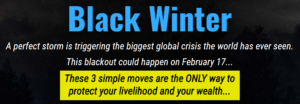
Keith Kohl pitches a doomsday winter scenario and says the only way to protect your portfolio is by riding a U.S.-led LNG boom. The hook: with Russian gas sidelined and years of underinvestment biting, America’s LNG export machine steps in. That broader setup isn’t far-fetched—the U.S. has been the world’s largest LNG exporter recently, per the EIA—but the real question is which stocks he’s actually teasing. (For context on Kohl’s style, see how we decoded his earlier “Infinite Lithium” tease and the “Quantum Computer King” pitch.)
First, the clues he drops—before we name names:
- Pick #1 clues: Owns one of the largest LNG production facilities globally; the day after the Russia–Ukraine war began, a French energy major inked a five-year LNG supply deal.
- Pick #2 clues: Runs a state-of-the-art, youngest LNG tanker fleet; hiked its dividend by 1,150% over three years.
- Pick #3 clues: American company that controls about 20% of the world’s LNG fleet; also owns regas plants from Peru to India.
How those clues line up:
- Cheniere Energy (NYSE: LNG) — The “largest facility” language points to Sabine Pass, the biggest U.S. LNG export plant; Cheniere is the flagship U.S. exporter at the center of the trend the EIA has highlighted (U.S. #1 by LNG exports in 2023), and Sabine Pass details are spelled out by the company itself.
- Flex LNG (NYSE: FLNG) — Fleet age is the tell; Flex’s modern carriers underpin that “youngest fleet” claim, and its payout ramp explains the 1,150% dividend line.
- Shell plc (NYSE: SHEL) — Shell is one of the world’s dominant LNG shippers and portfolio players; the “~20% of global LNG ships” + regas presence in Peru/India fits Shell’s global LNG footprint.
Bottom line: Kohl leans on a very real macro setup—U.S. LNG has been ascendant, and Sabine Pass is a crown jewel—but his trio isn’t obscure moonshots. It’s two blue-chips (Cheniere, Shell) and a pure-play shipper (Flex) set to benefit if LNG trade stays tight. That’s the same “picks-and-shovels” flavor we’ve seen in other energy pitches, like Nomi Prins’s LFP battery angle, which we unpacked in our review of her “EV Master Key” claim. For broader context on LNG’s rise and why U.S. exporters have momentum, the EIA’s data is worth a look, and Cheniere’s own Sabine Pass page shows why that asset keeps showing up in teasers.
>> Read the full write-up here
“Invictus” Stocks
- Title of Teaser Presentation: “Invictus”
- Name of “Special” Reports: “Invictus: 3 Stocks for Riding the $47 Trillion Superboom”
- Promoted Under: Technology and Opportunity

Keith Kohl frames “Invictus” as the tech wave that could out-muscle blockchain, AI, and 5G combined — and he pins a big reveal to June 30, 2022. The core promise: quantum computing is finally crossing from lab curiosity to money-maker, with “a handful of small caps” positioned to soar. If the tone sounds familiar, it’s the same “master key to everything” style we’ve seen in pitches like Navellier’s AI teaser.
Here are the clues dropped before any tickers were named:
- One “top 5 tech company of the quantum era” with a secretive R&D arm that’s made a major breakthrough.
- A so-called “Intel killer,” the first outfit to build a dedicated factory for quantum machines.
- A little-known contractor with dozens of U.S. federal deals, selling quantum strategy and technical expertise.
- A “70-stocks-in-one” way to play the whole trend (an ETF).
How those clues line up (and who’s who):
- The “top 5 tech” breakthrough player fits Honeywell (HON) — its quantum unit merged with Cambridge Quantum to form Quantinuum, a full-stack quantum company Honeywell still controls. That combo is exactly the kind of stealthy, well-funded R&D story Kohl describes. Honeywell’s merger announcement is here for context.
- The “Intel killer” with the first quantum factory points to Rigetti Computing (RGTI), which has long touted “Fab-1,” a dedicated in-house quantum device manufacturing facility and has sold on-prem systems. That “we built the fab” angle is Rigetti’s calling card.
- The contractor with “dozens” of federal contracts wasn’t nailed down in the exposé — the clues were too generic to identify confidently.
- The 70-stock basket is Defiance Quantum ETF (QTUM), which tracks a quantum/ML index and spreads risk across the ecosystem — a sensible hedge given the field’s timelines.
Bottom line: Kohl’s “Invictus” isn’t a new gadget; it’s just quantum computing dressed up with a deadline. For readers new to the space, this is the realm of qubits and superposition, not faster classical chips — and the commercial ramp is uneven, with lots of R&D spend and a few early use cases. If you want a sober primer on what quantum can and can’t do yet, MIT Sloan has a clear overview of where things stand and what might actually reach businesses. Good explainer here. MIT Sloan And Kohl’s “billions are flowing in” line is broadly true: Deloitte tallied more than $5B in 2021 when you include government allocations — a helpful reminder that hype cycles and budgets aren’t the same thing as revenues.
>> Read the full write-up here
His “Infinite Lithium” Pick
- Title of Teaser Presentation: “Infinite Lithium”
- Name of “Special” Reports: “‘Infinite Lithium’: How to Get in on the Ground Floor of the Energy Breakthrough of the Century”
- Promoted Under: Energy Investor
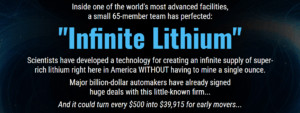
Here he pitches a small team with a zero-emission, water-free way to crank out “new” domestic lithium without mining—supposedly unlocking a flood of EV-grade supply and life-changing gains. The big idea isn’t sci-fi; it’s lithium-ion battery recycling, the same theme we’ve seen recycled (pun intended) in pitches like Dave Forest’s $4 lithium play.
Clues he drops before the reveal:
- ~$985M in deals/agreements with major automakers and battery makers
- Stock trades under $10
- A $100M investment from Koch Strategic Platforms to scale in North America
- Building out facilities in the U.S. (Arizona, Alabama; a big NY “hub” was part of the plan)
- Claims of an emissions-free process that doesn’t waste water
Those line up neatly with Li-Cycle Holdings (NYSE: LICY)—the Canadian battery-recycling outfit that took the SPAC route in 2021, later announced a $100M convertible note from Koch Strategic Platforms to expand its “Spoke & Hub” network, and pursued a large Rochester, NY processing hub. Recycling is a real path to closing the materials gap (the EPA’s primer on Li-ion recycling lays out why), and industry coverage at the time highlighted Koch’s backing of Li-Cycle to accelerate capacity build-out in North America (e.g., Utility Dive’s write-up on the $100M investment).
Bottom line: Kohl’s “Infinite Lithium” isn’t magic—it’s the circular-economy pitch. The catch is this space is crowded (Retriev, Redwood, RecycLiCo, etc.), capital-intensive, and timelines slip. So while Li-Cycle matched the clues, the “40x” talk felt like promotional gloss rather than base-case math.
>> Read the full write-up here
“Quantum Computer King” Stock
- Title of Teaser Presentation: “The Quantum Computer King”
- Name of “Special” Reports: “The Quantum Computer King: The #1 Stock to Buy for the Quantum Era”
- Promoted Under: Topline Trader
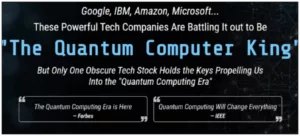
Keith Kohl’s pitch here is classic hype: a tiny stock supposedly sitting at the center of a $1 trillion quantum computing boom. He compares it to buying Intel in 1981 and even throws around a 31,594% return figure to make sure no one’s coffee stays in their cup.
The clues he drops are more telling than he’d like:
- A powerhouse in spintronics with over 100 worldwide patents.
- Manufactures spintronic devices and licenses IP to major tech companies.
- Growing at 56.5% with profit margins near 54%.
- Valued at about 0.2% of Intel’s market cap.
Add it all up and the company teased is NVE Corp. (Nasdaq: NVEC) — a spintronics specialist with more than 100 patents, fat profit margins, and a ~$293M market cap (around 0.2% of Intel’s $211B at the time). Spintronics, by the way, is the branch of nanotech that uses the spin of electrons in place of traditional bits, and it’s seen as a key enabler for quantum computing and faster data storage.
Kohl compares NVE’s potential to the early days of Intel, but as we’ve seen with other grand claims — like Charles Mizrahi's “Forever Battery” tease — the reality is often far less world-changing than advertised. NVE is a solid, profitable company with a nice dividend, but whether it leads us into the quantum era is a big question mark.
>> Read the full write-up here
That “LiDAR King” Pick
- Title of Teaser Presentation: N/A
- Name of “Special” Reports: “LiDAR King: The Tiny Tech Firm Destroying Tesla's Driverless Ambition”
- Promoted Under: Energy Investor

Keith Kohl went big on this one, teasing a tiny sensor company that he says could make investors 16,795% richer. The pitch? This “LiDAR King” supposedly holds the key to making self-driving cars safe and practical, with lasers that create 3D maps of surroundings.
Some of the clues Kohl dropped:
- The tech is already being tested in Tesla models.
- Fortune 500 companies like FedEx, Domino’s, and Microsoft are interested.
- Big names like Google, Amazon, BMW, and Audi have sunk billions into LiDAR-related projects.
- The firm has hundreds of projects in the works and dozens of patents.
- It’s been called the “King of the Road” by Boston Consulting Group.
Put all that together, and the company Kohl is hyping is Velodyne Lidar (NASDAQ: VLDR), a San Jose-based firm that’s one of the early leaders in the LiDAR sensor market. Velodyne has supplied over 300 clients and holds 70+ patents.
Kohl paints this as a once-in-a-lifetime driverless car play, but the reality is murkier. LiDAR is indeed used in autonomous vehicles and even in fields like farming and disaster recovery, but competition is fierce, margins are thin, and Tesla’s Elon Musk himself has repeatedly called LiDAR a “crutch.” That hasn’t stopped promoters from pushing similar angles before—see Jeff Brown’s “S.C.G.” teaser—but the payoff rarely matches the hype.
>> Read the full write-up here
Picks from 2021
His “Star Gas” Helium Stock Pitch
- Title of Teaser Presentation: “Jeff Bezos Sells BILLIONS in Amazon Shares to Chase Galactic ‘Star Gas'”
- Name of “Special” Reports: “Star Gas Trillions: 30-Fold Gains As Helium Rises”
- Promoted Under: Family Office Advantage
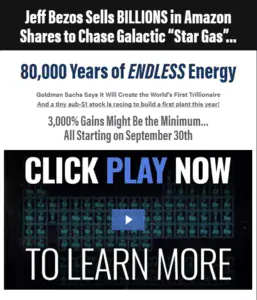
Keith Kohl is back with another bombastic pitch, this time hyping “Star Gas” — supposedly the key to “infinite energy” and generational wealth. He claims this mysterious fuel could solve humanity’s energy needs for 80,000 years and mint “25 million new billionaires.” The sales hook? A tiny helium stock trading under $1.
The clues dropped include:
- Recently IPO’d in 2021.
- Stock trades below $1.
- Owns land he dubs the “Saudi Arabia of Helium.”
- Involved in helium drilling and building a pilot plant, with production testing and first plant coming online by September 30.
- Early estimates show over 1.1 billion cubic feet of helium at its project.
- Financing was done at $0.25 per share.
Following those hints leads to Imperial Helium Corp. (TSX.V: IHC). The match is pretty clean: IPO’d in May 2021, focused on its Steveville, Alberta acreage with over 1 billion cubic feet of helium potential, and shares well under $1. The company had also just begun production testing — lining up with Kohl’s September timeline.
To be fair, helium is indeed critical — from MRI machines to semiconductors — and it’s becoming scarce on Earth despite being abundant in the universe. Prices have surged, and demand is projected to outstrip supply for years. But turning a mid-tier Canadian driller into the source of “25 million billionaires”? That’s classic newsletter hyperbole.
>> Read the full write-up here
“On-Demand Everything” Drone & Robot Picks
- Title of Teaser Presentation: “Bezos' Secretive ‘Project Talos' to Elipse Amazon?!”
- Name of “Special” Reports: “The Tiny Tech Firm Mass-Manufacturing LiDAR”, “Robotic Navigation: How One Company Is Enabling an Autonomous Future”, “Staking Your Claim in the Skyways of Tomorrow”
- Promoted Under: Technology and Opportunity

Here we've got Mr. Kohl teasing what he calls the “On-Demand Everything” revolution — the idea that drones, robots, and autonomous tech will make two-day shipping look outdated. He claims Jeff Bezos is pouring billions into this “Project Talos” and hints it could eclipse Amazon itself.
The clues he drops are pretty specific. He talks about:
- A “tiny black box” LiDAR device whose price has dropped 99.8%, from $75,000 to just $100. It already has 16 patents, major investors like Nikon, Ford, and Baidu, and secured $130M in contracts projecting nearly $1B in revenue by 2024.
- A Rhode Island company whose photonic navigation tech lets robots operate even without GPS, with products in 200,000+ mobile satellite antennas and 22,000+ military vehicles.
- A drone-delivery startup positioning itself as the first “Drone Delivery as a Service” provider in North America, renting out drones to everyone from construction firms to mom-and-pop shops.
Based on these details, two of Kohl’s teased stocks line up well:
- Velodyne Lidar Inc. (Nasdaq: VLDR) for the cheap LiDAR “black box” tech.
- KVH Industries, Inc. (Nasdaq: KVHI) for the navigation and GPS-alternative systems.
The third drone-delivery stock remains vague, and with plenty of startups chasing the space, the match wasn’t nailed down.
We've seen similar futuristic flavored stock picks before, the difference is Kohl’s angle leans heavily on robots, drones, and the logistics industry’s shift into autonomy.
And while drones zipping through city skies may sound like sci-fi, the enabling piece — LiDAR sensors — really has come a long way in cost and availability. If “on-demand everything” is going to happen, it starts there.
>> Read the full write-up here
That “TriFuel-238” Nuclear Fuel Play
- Title of Teaser Presentation: “America's Next Energy Revolution Will Be Powered by ‘TriFuel-238′”
- Name of “Special” Report: “The Undiscovered Tech Company Behind the Coming TriFuel-238 Revolution”
- Promoted Under: Energy Investor

Here we have Keith dangling what he calls “TriFuel-238,” supposedly the next great leap in renewable energy. He claims it’s a twisted metal fuel rod that can power a home for 15 years, retrofit any coal plant, and turn a $5k investment into $1.2 million. In his telling, it’s a $48 billion “cash grab” and a fix for America’s looming “silent energy crisis.”
Some of the more specific clues dropped: the company has just 13 key employees and is based near Virginia, it partnered with nuclear giant Framatome, has deals with two utilities operating 15 reactors, and billionaires like Gates and Bezos are circling. The firm supposedly has a $6.9 billion opportunity to refit plants for this fuel.
Put all that together and the match is Lightbridge Corp. (NASDAQ: LTBR). It’s an early-stage nuclear fuel developer headquartered in Reston, Virginia. Lightbridge had a JV with Framatome, has ties to the U.S. Department of Energy, and is trying to commercialize metallic nuclear fuel rods that promise to be cheaper and safer than conventional uranium oxide rods.
The problem? It’s a $40 million microcap with no revenue, burning cash every year. Kohl’s hyped “46,000%” returns are classic newsletter math, not anything grounded in Lightbridge’s current fundamentals.
If nuclear fuel innovation ever takes off, Lightbridge could have a role, but this isn’t the slam-dunk, trillion-dollar breakthrough being implied. For now, it’s speculative R&D with a long, uncertain road to adoption.
>> Read the full write-up here
Picks from 2020
His “5G Volta” Grid Sensor Play
- Title of Teaser Presentation: “5G Volta”
- Name of “Special” Report: “5G-Volta: Retire Rich on the Power Grid’s Upgrade of the Century”
- Promoted Under: Energy Investor
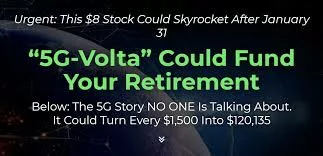
Keith Kohl's been hyping something he calls “5G Volta” — a supposed $1.5 trillion government-backed program that will overhaul the U.S. power grid and supposedly mint early investors fortunes. He compares it to getting into Nvidia or Cisco before their huge runs, tossing around promises of 4,000%+ gains.
The clues he drops:
- A warehouse in upstate New York making “tiny modules no bigger than 10 grains of salt.”
- These modules are “the critical centerpiece” of Executive Order 13920, which focused on securing the U.S. bulk power system.
- The modules are RF filters used in 5G-connected sensors to monitor the grid.
- The stock trades around $8 per share with a $314 million market cap.
- The company holds 32 patents in this area.
Match those up and it’s a dead ringer for Akoustis Technologies (NASDAQ: AKTS). They’re a New York-based RF filter maker with patented XBAW tech that fits the description. Kohl tries to rebrand the federal grid modernization push as “5G Volta,” but really it’s about deploying millions of 5G-enabled sensors to improve resilience and renewable integration.
>> Read the full write-up here
Texas Oil Company
- Title of Teaser Presentation: “Reclusive Millionaire Pours #3 Million Into New Texas Oil Discovery”
- Name of “Special” Report: Not explicitly named, part of Pure Energy Trader promo
- Promoted Under: Pure Energy Trader
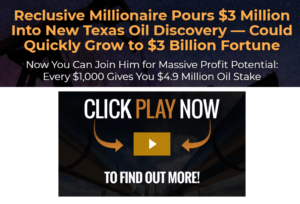
Keith's pitch starts off with a bang: a mysterious reclusive millionaire drops $3 million into a tiny Texas driller, supposedly sitting on “the most exciting U.S. oil discovery in a decade.” He claims this one play could turn every $1,000 into $4.9 million — thanks to a “secret anomaly” that lets you buy crude oil for pennies on the dollar.
The clues?
- It’s a Texas oil explorer with a market cap around $50 million.
- Has a 100,000-acre claim in the Permian Basin.
- Insiders own about 30% of the shares.
- Shares were trading at 40 cents earlier in 2020.
Put those together and it leads us straight to Torchlight Energy Resources (NASDAQ: TRCH). They own the Orogrande Project — just over 100,000 acres — and company insiders hold close to 30%. They even brought in industry veteran Mike Mullen to validate their data, though his assessment was based on optimistic estimates.
The problem? Oil prices were crushed in 2020, and Torchlight was already under Nasdaq delisting pressure. With production costs in the Permian Basin hovering around $36–$40 per barrel — about the same as market prices — Torchlight was set to bleed cash unless oil spiked. Not exactly the no-risk jackpot Kohl made it sound like.
>> Read the full write-up here
Who Is Keith Kohl?
You've seen him teasing the heck out of the next best stock picks to get rich, but who is this guy, and should you really be listening to him?

Keith runs several investment newsletter publications over at Angel Publishing and has hundreds of thousands of readers.
His main focus is in the energy markets, hence his one newsletter's name – Energy and Capital – but also recommends stocks in biotech and other sectors.
Some of the information I've found states that “his network includes hundreds of experts, from M.S.s and Ph.D.s to lab scientists”, but of course, this is something anyone can say.
And after looking at his Linkedin profile, which shows he's been a managing editor over at Angel Publishing since 2006, there's nothing that builds my confidence. According to this, he graduated from Millersville University of Pennsylvania with two bachelor's degrees… in History and English Language and Literature/Letters.
Nothing to do with investing, but we don't care all too much about credentials here at Green Bull Research. We just want what works, and according to a small snippet of information I found about Mr. Kohl from Cabot Wealth Network, he is:
one of the only financial reporters around who’s actually visited Alberta’s remote tar sands region to personally meet every major player in the booming Canadian oil operation.
And, of course, if you believe that at least some of his investment teaser presentation videos are real, you can see that he gets his boots on the ground quite a bit.
Conclusion & Should You Buy Keith Kohl's Recommendations?
What we do on this website is uncover recommendations by Keith Kohl and other “experts” so that our readers, such as you, can learn what they are teasing for free. But, this certainly doesn't mean we recommend buying what they recommend.
This is the only stock-picking service we actually recommend and it isn't run by Keith Kohl.
We aren't telling you not to buy his rec's either. Just be sure to do your own due diligence before making any investment decisions, especially those that come with a lot of over-the-top hype as Mr. King's do.
As always, let us know what you think of these picks in the comment section below. And if you have any other picks of his that you wouldn't mind sharing, we'd love to hear about them!

